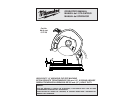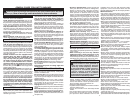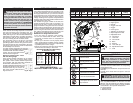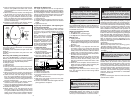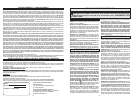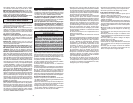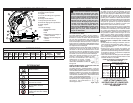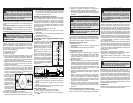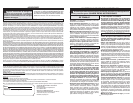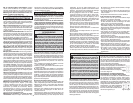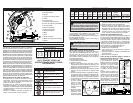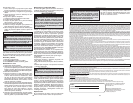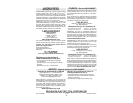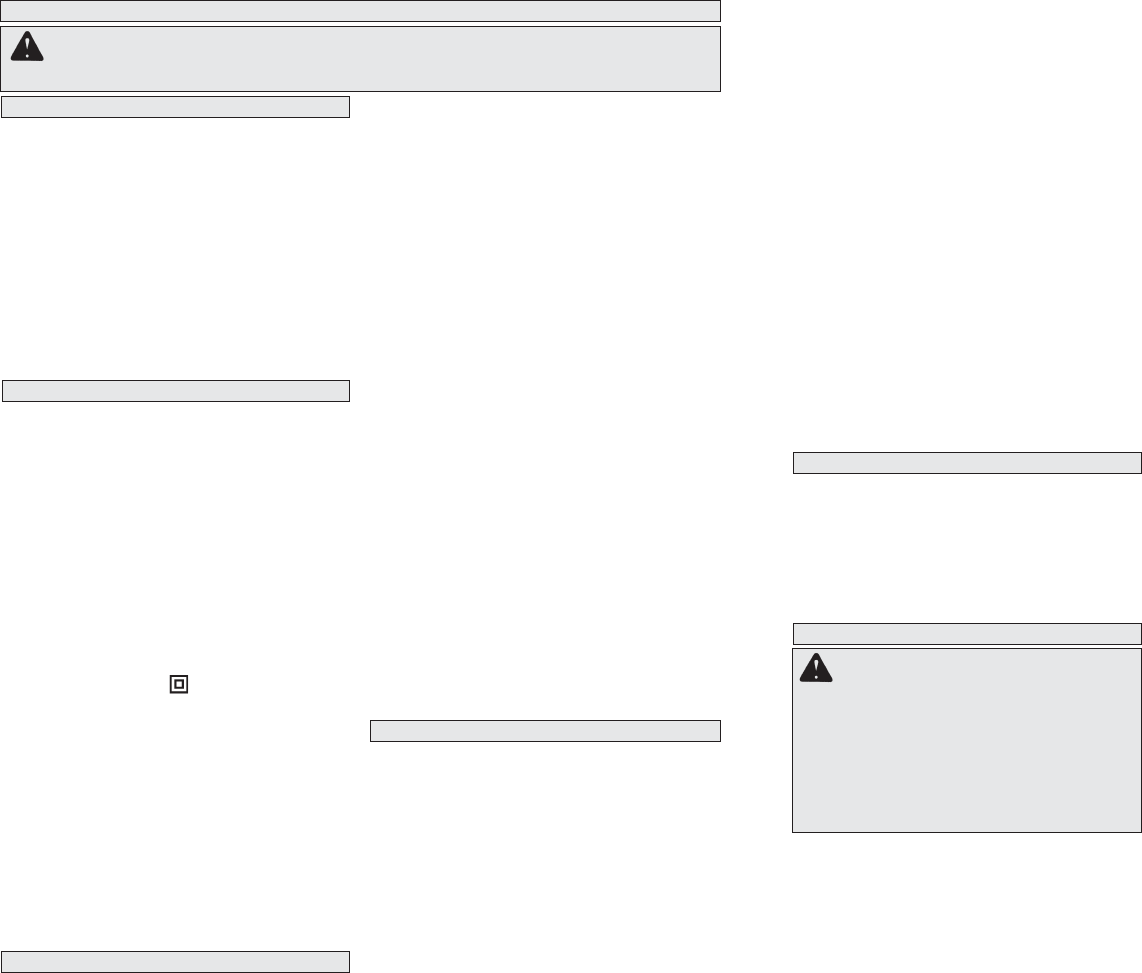
2
3
PERSONAL SAFETY
GENERAL POWER TOOL SAFETY WARNINGS
WORK AREA SAFETY
ELECTRICAL SAFETY
• Keep work area clean and well lit. Cluttered,
dark work areas invite accidents.
• Avoid dangerous environments. Do not use
your power tool in rain, damp or wet locations or in
the presence of explosive atmospheres (gaseous
fumes, dust or fl ammable materials). Remove
materials or debris that may be ignited by sparks.
• Keep bystanders away. Children and bystanders
should be kept at a safe distance from the work
area to avoid distracting the operator and contact-
ing the tool or extension cord.
• Protect others in the work area from debris such
as chips and sparks. Provide barriers or shields
as needed.
• Make workshop child proof with padlocks,
master switches, or by removing starter keys.
• Grounded tools must be plugged into an outlet
properly installed and grounded in accordance
with all codes and ordinances. Never remove
the grounding prong or modify the plug in any way.
Do not use any adaptor plugs. Check with a quali-
fi ed electrician if you are in doubt as to whether
the outlet is properly grounded. If the tool should
electrically malfunction or break down, grounding
provides a low resistance path to carry electricity
away from the user.
• Double insulated tools are equipped with a
polarized plug (one blade is wider than the
other). This plug will fi t in a polarized outlet
only one way. If the plug does not fi t fully in
the outlet, reverse the plug. If it still does not
fi t, contact a qualifi ed electrician to install a
polarized outlet. Do not change the plug in any
way. Double insulation
eliminates the need for
the three wire grounded power cord and grounded
power supply system.
• Guard against electric shock. Prevent body con-
tact with grounded surfaces such as pipes, radia-
tors, ranges and refrigerators. When making blind
or plunge cuts, always check the work area for
hidden wires or pipes. Hold your tool by insulated
nonmetal grasping surfaces. Use a Ground Fault
Circuit Interrupter (GFCI) to reduce shock hazards.
• Do not expose to rain or use in damp locations.
• Do not abuse the cord. Never use the cord to
carry the tools or pull the plug from an outlet.
Keep cord away form heat, oil, sharp edges
or moving parts. Replace damaged cords im-
mediately. Damaged cords increase the risk of
electric shock.
WARNING READ ALL SAFETY WARNINGS AND ALL INSTRUCTIONS.
Failure to follow the warnings and instructions may result in electric shock, fi re and/or
serious injury. Save all warnings and instructions for future reference.
POWER TOOL USE AND CARE
• Stay alert, watch what you are doing, and
use common sense when operating a power
tool. Do not use tool while tired or under the
infl uence of drugs, alcohol, or medication. A
moment of inattention while operating power tools
may result in serious personal injury.
• Dress properly. Do not wear loose clothing or
jewelry. Wear a protective hair covering to contain
long hair. These may be caught in moving parts.
When working outdoors, wear rubber gloves and
insulated non-skid footwear. Keep hands and
gloves away from moving parts.
• Reduce the risk of unintentional starting. Be
sure your tool is turned off before plugging it in.
Do not use a tool if the power switch does not turn
the tool on and off. Do not carry a plugged-in tool
with your fi nger on the switch.
• Remove all adjusting keys and wrenches. Make
a habit of checking that adjusting keys, wrenches,
etc. are removed from the tool before turning it on.
• Do not overreach. Maintain control. Keep proper
footing and balance at all times. Maintain a fi rm
grip. Use extra care when using tool on ladders,
roofs, scaffolds, etc.
• Use safety equipment. Everyone in the work area
should wear safety goggles or glasses with side
shields complying with current safety standards.
Everyday eyeglasses only have impact resistant
lenses. They are not safety glasses. Wear hearing
protection during extended use and a dust mask
for dusty operations. Hard hats, face shields,
safety shoes, etc. should be used when specifi ed
or necessary. Keep a fi re extinguisher nearby.
• Keep guards in place and in working order.
• Never stand on tool. Serious injury could occur if
the tool is tipped or if the cutting tool is unintention-
ally contacted.
• Keep hands away from all cutting edges and
moving parts.
• Secure work. Use a clamp, vise or other practical
means to hold your work securely, freeing both
hands to control the tool.
• Do not force tool. Your tool will perform best at
the rate for which it was designed. Excessive force
only causes operator fatigue, increased wear and
reduced control.
• Use the right tool. Do not use a tool or attach-
ment to do a job for which it is not recommended.
For example, do not use a circular saw to cut tree
limbs or logs. Do not alter a tool.
• Unplug tool when it is not in use, before changing
accessories or performing recommended mainte-
nance.
• Store idle tools. When not in use, store your tool in
a dry, secured place. Keep out of reach of children.
• Never leave the tool running unattended. Turn
power off. Do not leave the tool until it comes to a
complete stop.
• Know your power tool. Read this manual care-
fully to learn your power tool’s applications and
limitations as well as potential hazards associated
with this type of tool.
SPECIFIC SAFETY RULES
• Check for damaged parts. Inspect guards and
other parts before use. Check for misalignment,
binding of moving parts, improper mounting,
broken parts and any other conditions that may
affect operation. If abnormal noise or vibration
occurs, turn the tool off immediately and have the
problem corrected before further use. Do not use
a damaged tool. Tag damaged tools “DO NOT
USE” until repaired. A guard or other damaged
part should be properly repaired or replaced by a
MILWAUKEE service facility. For all repairs, insist
on only identical replacement parts.
• Use proper accessories. Consult this manual
for recommended accessories. Using improper
accessories may be hazardous. Be sure acces-
sories are properly installed and maintained. Do
not defeat a guard or other safety device when
installing an accessory or attachment.
• Maintain tools carefully. Keep handles dry,
clean and free from oil and grease. Keep cutting
edges sharp and clean. Follow instructions for
lubricating and changing accessories. Periodically
inspect tool cords and extension cords for damage.
Have damaged parts repaired or replaced by a
MILWAUKEE service facility.
• Maintain labels & nameplates. These carry impor-
tant information. If unreadable or missing, contact a
MILWAUKEE service facility for a free replacement.
SERVICE
• Tool service must be performed only by quali-
fi ed repair personnel. Service or maintenance
performed by unqualifi ed personnel may result in
a risk of injury.
• When servicing a tool, use only identical
replacement parts. follow instructions in the
maintenance section of this manual. Use of
unauthorized parts or failure to follow maintenance
instructions may create a risk of shock or injury.
• WARNING: Some dust created by power sanding,
sawing, grinding, drilling, and other construction
activities contains chemicals known to cause
cancer, birth defects or other reproductive harm.
Some examples of these chemicals are:
• lead from lead-based paint
• crystalline silica from bricks and cement and other
masonry products, and
• arsenic and chromium from chemically-treated
lumber.
Your risk from these exposures varies, depending
on how often you do this type of work. To reduce
your exposure to these chemicals: work in a well
ventilated area, and work with approved safety
equipment, such as those dust masks that are
specially designed to fi lter out microscopic particles.
Wheel Instructions
• Use only the edge (not the sides) of the wheel for
cutting. Do not allow the wheel to twist or bind.
• Keep hands and body away from the rotating wheel.
Do not wear loose clothing when using this tool.
• Store cut-off wheels with care. Do not drop them or
subject them to excessive heat, cold or humidity.
• Make sure that all wheel fl anges and other mount-
ing hardware are in good condition and are always
used properly. Defective or missing parts may
cause damage to the wheel. Always use mounting
fl anges supplied with the tool.
• Cutting with a damaged wheel is very hazard-
ous. After installing a new wheel, leave the tool
unplugged and rotate the wheel by hand to see
if it is uneven, warped, or cracked. If so, discard
the wheel and replace it with a new one. Do not
use a wheel that has been dropped; impact may
result in breakage.
• Before starting a cut, step back from the tool and
make a trial run to confi rm that the wheel is in good
condition. Trial run periods are:
When replacing a cut-off wheel — over 3 minutes.
When starting routine work — over 1 minute.
• Never try to remove or clamp the workpiece to the
tool while the cut-off wheel is rotating.
• Before installing a cut-off wheel, always inspect
it for cracks. Visually check resinoid and rubber-
bonded wheels for cracks. Replace cracked wheel
immediately.
• Always check maximum operating speed estab-
lished for wheel against machine speed. Do not
exceed the maximum operating speed that is
marked on the wheel.
• Do not force a wheel onto the machine or alter the
size of the arbor hole. Don’t use a wheel that fi ts
the arbor too loosely. If the wheel doesn’t fi t the
machine, get one that does.
• Do not attempt to install saw blades on this tool
because it is not designed for this type of blade.
• Do not overtighten wheel nut.
Machine Instructions
• Start cutting only after the motor has reached full
speed.
• Release switch immediately if the cut-off wheel
stops rotating or if the motor sounds like it is straining.
• Keep fl ammable and fragile objects away from
this tool. Do not allow cut-off sparks to contact the
operator’s hands, face or feet.
• Place the tool securely on a fl at, level surface.
• Always use the tool with the proper voltage speci-
fi ed on the tool’s nameplate.
• Never touch a short cut-off piece until it cools.
• Never attempt to cut material larger than the rated
capacity listed in “Specifi cations”.
• Never stand in line with the wheel while cutting.
Always stand to the side.
• Always keep guards in place.
• Always start the cut gently. Do not bump or bang
a wheel to start a cut.
• Never make any freehand cuts. Always place the work-
piece between the vise and fence when making cuts.
WARNING To reduce the risk of injury,
avoid inhalation of dust generated by
grinding and cutting operations. Exposure
to dust may cause respiratory ailments.
Use approved NIOSH or OSHA respirators,
safety glasses or face shields, gloves and
protective clothing. Provide adequate
ventilation to eliminate dust, or to maintain
dust level below the Threshold Limit Value for
nuisance dust as classifi ed by OSHA.



